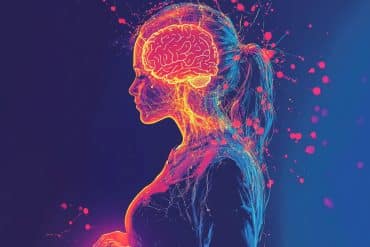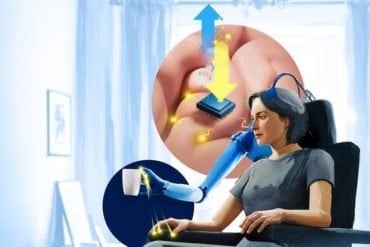Unique research led by NYU Langone Medical Center utilizes music videos to study eye movements.
Researchers at NYU Langone Medical Center have developed new technology that can assess the location and impact of a brain injury merely by tracking the eye movements of patients as they watch music videos for less than four minutes, according to a study published Friday on-line in the Journal of Neurosurgery.
The study suggests that the use of eye tracking technology may be a potential biological marker for assessing brain function and monitoring recovery for patients with brain injuries.
Led by Uzma Samadani, MD, PhD, chief of neurosurgery at New York Harbor Health Care System and co-director of the Steven & Alexandra Cohen Veterans Center for the Study of Post-Traumatic Stress and Traumatic Brain Injury at NYU Langone, the study looked at 169 veterans; 157 of whom were neurologically healthy and 12 who either had known weaknesses in the nerves that move the eyes, or brain swelling adjacent to those nerves. These nerves affect how the eye moves up and down and side to side.
Using a technology developed at NYU Langone, the investigators had the participants watch a music video or television content for 220 seconds while they measured the ratio of horizontal to vertical eye movements. They discovered that in the neurologically healthy subjects, the ratios were close to one-to-one, with horizontal movements equaling vertical movements. But the 12 participants with nerve damage or swelling in the brain pressing on nerves all showed abnormal eye movement ratios correlating to the nerve that was affected. In every case where the abnormal eye movement was due to swelling in the brain, surgery to fix the brain problem also restored the eye movements to normal range.

“We are very excited about the findings because it offers a proof of concept that this technology can detect brain injury and suggest its location,” says Dr. Samadani. “One of the reasons that clinical trials for treatment of brain injury have failed in the past is that brain injury is hard to classify and quantitate with existing technologies. This invention suggests a potential new method for classifying and quantitating the extent of injury. Once validated, it will both accelerate diagnosis and aid in the development of better treatments.”
Commenting on the study, Charles Marmar, MD, the Lucius Littauer professor and chairman of Psychiatry at NYU Langone, and executive director of NYU Langone’s Steven & Alexandra Cohen Veterans Center (which helps fund Dr. Samadani’s research), says: “These results are extremely exciting because the technology is not overly complicated and, as a result, can move from the bench to the battlefield and other places where it will be easily accessible to all.”
Dr. Marmar added that because of its easy usability, it can be applied, for example, to study hundreds of subjects in a relatively short period of time. He pointed in particular to recent eye-tracking work led by Dr. Samadani of over 600 active military at Fort Campbell in Kentucky, who were assessed with this technology in the first week after they returned home from their deployment. “These studies will help further evaluate the technology’s effectiveness as a screening tool,” he adds.
Brain injury is the number one cause of death and disability in Americans under age 35, According to the U.S. Centers for Disease Control and Prevention. Every year, 1.4 million people suffer from a traumatic brain injury in the United States. Of those, 50,000 die and 235,000 require hospital admission.
While the paper describes patients with brain problems that are apparent on imaging, Dr. Samadani says the technology will likely be most useful for the assessment of concussion and blast injury – which can be difficult to detect with standard imaging studies, and which is highly prevalent among returning veterans from the long Middle East wars. “Because eye tracking measures how well the brain functions rather than assesses what it looks like, it provides very different information than imaging studies” she says.
It may also be helpful for triage. “When a person falls and hits their head, it can be difficult to determine whether the injury is life-threatening,” Dr. Samadani says. “Eye tracking is potentially a simple, non-invasive and cost-effective way to determine quickly which patients need immediate attention.”
In addition to Dr. Samadani, co-authors of this study include Sameer Farooq; Robert Ritlop, MEng.; Floyd Warren, MD; Marleen Reyes, BA; Elizabeth Lamm, BA; Anastasia Alex, BS; Elena Nehrbass, BS; Radek Kolecki, BS; Michael Jureller, BS; Julia Schneider; Agnes Chen, BA; Chen Shi, BS; Neil Mendhiratta, BA; Jason H. Huang, MD; Meng Qian, PhD; Roy Kwak, MD; Artem Mikheev, MS; Henry Rusinek, PhD; Ajax Goerge, MD; Robert Fergus, PhD; Douglas Kondziolka, MD; Paul P. Huang, MD; and Theodore Smith, Md, PhD.
Dr. Samadani’s research is supported in part by the U.S. Department of Veterans Affairs (VA), Veterans Health Administration, Office of Research and Development, Rehabilitation and Research and Development Service via a VA Merit Award (1I01RX000319-01); a Career Development Award from the American College of Surgeons/Neurosurgery Research Education Foundation of the AANS; the Steven & Alexandra Cohen Veterans Center for the Study of Post-Traumatic Stress and Traumatic Brain Injury; The Thrasher Research Fund; and Research to Prevent Blindness.
Contact: Jim Mandler – NYU Langone Medical Center
Source: NYU Langone Medical Center press release
Image Source: The image is credited to NYU Langone Medical Center
Original Research: Abstract for “Detection of third and sixth cranial nerve palsies with a novel method for eye tracking while watching a short film clip” by Uzma Samadani, MD, PhD, Sameer Farooq, Robert Ritlop, MEng, Floyd Warren, MD, Marleen Reyes, BA, Elizabeth Lamm, BA, Anastasia Alex, BS, Elena Nehrbass, BS, Radek Kolecki, MS, Michael Jureller, BS, Julia Schneider, Agnes Chen, BA, Chen Shi, BS, Neil Mendhiratta, BA, Jason H. Huang, MD, Meng Qian, PhD, Roy Kwak, MD, Artem Mikheev, MS, Henry Rusinek, PhD, Ajax George, MD, Robert Fergus, PhD, Douglas Kondziolka, MD, Paul P. Huang, MD, and R. Theodore Smith, MD, PhD in Journal of Neurosurgery. Published online December 12 2014 doi:10.3171/2014.10.JNS14762






